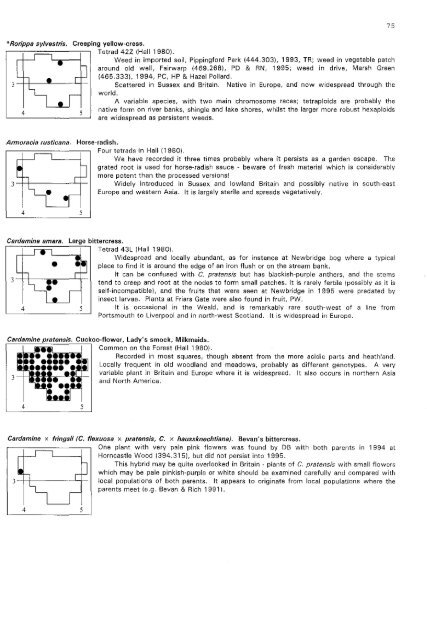Flora of Ashdown Forest - Botanical Society of the British Isles
Flora of Ashdown Forest - Botanical Society of the British Isles
Flora of Ashdown Forest - Botanical Society of the British Isles
Create successful ePaper yourself
Turn your PDF publications into a flip-book with our unique Google optimized e-Paper software.
75*Rorippa sylvestris. Creeping yellow-cress.Tetrad 42Z (Hall 1980).Weed in imported soil, Pippingford Park (444.3031. 1993, TR; weed in vegetable patcharound old well, Fairwarp (469.268), PD & RN, 1995; weed in drive, Marsh Green(465.3331. 1994, PC, HP & Hazel Pollard.J ++------"'-------Lf- Scattered in Sussex and Britain. Native in Europe, and now widespread through <strong>the</strong>world.A variable species, with two main chromosome races; tetraploids are probably <strong>the</strong>native form on river banks, shingle and lake shores, whilst <strong>the</strong> larger more robust hexaploids4 5are widespread as persistent weeds,Armor8cia rusticana. Horse-radish.Four tetrads in Hall 11980).We have recorded it three times probably where it persists as a garden escape. Thegrated root is used for horse-radish sauce - beware <strong>of</strong> fresh material which is considerablymore potent than <strong>the</strong> processed versions!J ++-------'-1- Widely introduced in Sussex and lowland Britain and possibly native in south-eastEurope and western Asia. It is largely sterile and spreads vegetatively.4 5Cardamine amara. large bittercress.,---,---------';-, Tetrad 43L (Hall 1980).J -++--..... :---'-+-4 5Widespread and locally abundant, as for instance at Newbridge bog where a typicalplace to find it is around <strong>the</strong> edge <strong>of</strong> an iron flush or on <strong>the</strong> stream bank.It can be confused with C. pratensis but has blackish-purple an<strong>the</strong>rs, and <strong>the</strong> stemstend to creep and root at <strong>the</strong> nodes to form small patches. It is rarely fertile {possibly as it isself-incompatible), and <strong>the</strong> fruits that were seen at Newbridge in 1995 were predated byinsect larvae. Plants at Friars Gate were also found in fruit, PW,It is occasional in <strong>the</strong> Weald, and is remarkably rare south-west <strong>of</strong> a line fromPortsmouth to Liverpool and in north-west Scotland. It is widespread in Europe."C:.:a"r.::d::;-8:..:m:..:i::n::e=p::r::8:=-te::n",s::,.::·s,-.-,C:;""c:.:;koo-flower, lady's smock, Milkmaids.Common on <strong>the</strong> <strong>Forest</strong> (Hall 1980).Recorded in most squares, though absent from <strong>the</strong> more acidic parts and heathland.Locally frequent in old woodland and meadows, probably as different genotypes. A veryvariable plant in Britain and Europe where it is widespread. It also occurs in nor<strong>the</strong>rn Asiaand North America.4 5Cardamine x fringsii (C. flexuosa x pratensis, C. x haussknechtiana). Bevan's bittercress.One plant with very pale pink flowers was found by DB with both parents in 1994 atHorneastle Wood (394.315), but did not persist into 1995.This hybrid may be quite overlooked in Britain - plants <strong>of</strong> C, pratensis with small flowerswhich may be pale pinkish-purple or white should be examined carefully and compared with3 local populations <strong>of</strong> both parents. It appears to originate from local populations where <strong>the</strong>parents meet (e.g. Bevan & Rich 1991).4 5
















